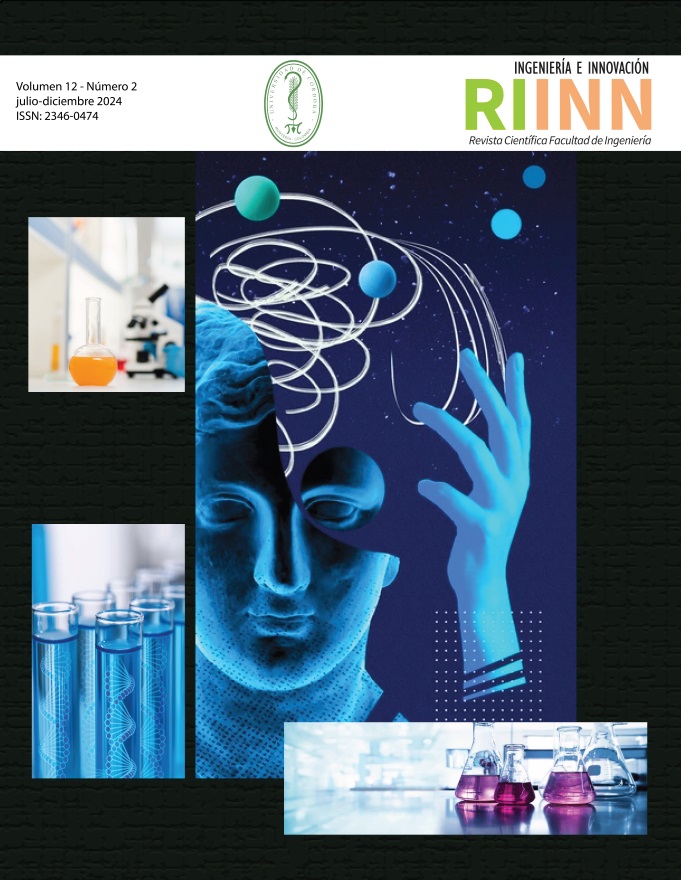Mostrar biografía de los autores
El objetivo de este artículo es analizar la implementación de tecnologías
emergentes en el deporte para mejorar la experiencia de atletas,
entrenadores y aficionados. El mundo del deporte está en constante
innovación, lo que exige un manejo eficiente de herramientas tecnológicas
especializadas. Estas tecnologías emergentes se enfocan en ayudar a los
deportistas a rendir mejor en el campo de juego, optimizar los regímenes de
entrenamiento y revolucionar los procesos de toma de decisiones. Mediante
el uso de algoritmos de aprendizaje automático, análisis predictivos y
tecnologías de visión por computadora, se pueden establecer estrategias
efectivas. Para este estudio, se seleccionaron 40 artículos de bases de datos
como Scopus, ScienceDirect e IEEE. Los principales hallazgos indican que
las herramientas tecnológicas no solo mejoran la competitividad, sino que
también ayudan a prevenir lesiones futuras.
Visitas del artículo 11 | Visitas PDF
Descargas
- Adesida, Y., Papi, E., & McGregor, A. H. (2019). Exploring the role of wearable technology in sport kinematics and kinetics: A systematic review.
- In Sensors (Switzerland) (Vol. 19, Issue 7). MDPI AG. https://doi.org/10.3390/s19071597
- ALEXANDER, W. LINDSAY. (2019). ST. PAUL AT ATHENS (CLASSIC REPRINT). FORGOTTEN BOOKS. Apostolou, K., & Tjortjis, C. (2019, July 1). Sports
- Analytics algorithms for performance prediction. 10th International Conference on Information, Intelligence, Systems and Applications, IISA 2019.
- https://doi.org/10.1109/IISA.2019.8900754
- Araújo, D., Couceiro, M., Seifert, L., Sarmento, H., & Davids, K. (2021). Artificial intelligence in sport performance analysis. In Artificial Intelligence in Sport Performance Analysis. Taylor and Francis. https://doi.org/10.4324/9781003163589
- Biró, A., Cuesta-Vargas, A. I., & Szilágyi, L. (2024). AI-Assisted Fatigue and Stamina Control for Performance Sports on IMU-Generated Multivariate Times Series Datasets. Sensors, 24(1). https://doi.org/10.3390/s24010132
- Calderón, R. (n.d.). Universidad La Salle Bienes comunes digitales de la Universidad La Salle Piedras angulares de la investigación forense sobre delitos
- económicos Programa forense de delitos económicos !e Beneficios de la Inteligencia Arti&cial en Ciberseguridad.
- Chen, G., & Wu, H. (2024). Optimization simulation of sports stadium training based on Ant colony algorithm and sensor network. Measurement:
- Sensors, 33, 101100. https://doi.org/10.1016/j.measen.2024.101100
- Chen, Z., & Dai, X. (2024). Utilizing AI and IoT technologies for identifying risk factors in sports. Heliyon, 10(11). https://doi.org/10.1016/j.heliyon.2024.e32477
- Chidambaram, S., Maheswaran, Y., Patel, K., Sounderajah, V., Hashimoto, D. A., Seastedt, K. P., McGregor, A. H., Markar, S. R., & Darzi, A. (2022). Using
- Artificial Intelligence-Enhanced Sensing and Wearable Technology in Sports Medicine and Performance Optimisation. In Sensors (Vol. 22, Issue 18). MDPI. https://doi.org/10.3390/s22186920
- De Oliveira, M. S., Steffen, V., & Trojan, F. (2023). A systematic review of the literature on video assistant referees in soccer: Challenges and
- opportunities in sports analytics. Decisión Analytics Journal, 7. https://doi.org/10.1016/j.dajour.2023.100232
- Fuss, F. K. , S. A. , S. M. , & M. R. (2014). Routledge Handbook of Sports Technology and Engineering. Routledge.
- Goel, A. (2024). IS TECHNOLOGY A COMPLEMENT OR SUBSTITUTE TO REFEREEING IN SPORTS? A REVIEW (Review study). IJSTS International Journal of Sport Technology
- and Science International Journal of Sports Technology and Science, 2(1), 13–23. https://www.globsportsjournal.com/
- Gsangaya, M. R., Htwe, O., Selvi Naicker, A., Md Yusoff, B. A. H., Mohammad, N., Soh, E. Z. F., & Silvaraju M. (2023). Comparison between the effect
- of immersive virtual reality training versus conventional rehabilitation on limb loading and functional outcomes in patients after anterior
- cruciate ligament reconstruction: A prospective randomized controlled trial. Asia-Pacific Journal of Sports Medicine, Arthroscopy, Rehabilitation and
- Technology, 34, 28–37. https://doi.org/10.1016/j.asmart.2023.09.002
- Jager, E. W. H., Inganäs, O., & Lundström, I. (2000). Microrobots for micrometer-size objects in aqueous media: Potential tools for single-cell manipulation. Science, 288(5475), 2335–2338. https://doi.org/10.1126/science.288.5475.2335
- Jenkins, L., & Weerasekera, R. (2022). Sport-related back injury prevention with a wearable device. Biosensors and Bioelectronics: X, 11. https://doi.org/10.1016/j.biosx.2022.100202
- Khuyen, N. Q., Kiefer, R., Elhi, F., Anbarjafari, G., Martinez, J. G., & Tamm, T. (2020). A biomimetic approach to increasing soft actuator performance by friction reduction. Polymers, 12(5). https://doi.org/10.3390/POLYM12051120
- Kovoor, M., Durairaj, M., Karyakarte, M. S., Zair Hussain, M., Ashraf, M., & Maguluri, L. P. (2024). Sensorenhanced wearables and automated analytics
- for injury prevention in sports. Measurement: Sensors, 32, 101054. https://doi.org/10.1016/j. measen.2024.101054
- Li, Y., Kim, M., & Palkar, J. (2022). Using emerging technologies to promote creativity in education: A systematic review. International Journal
- of Educational Research Open, 3. https://doi.org/10.1016/j.ijedro.2022.100177
- Liu, Y., & Cao, S. (2024). The analysis of aerobics intelligent fitness system for neurorobotics based on big data and machine learning. Heliyon, 10(12). https://doi.org/10.1016/j.heliyon.2024.e33191
- Lopez‐barreiro, J., Alvarez‐sabucedo, L., Garcia‐soidan, J. L., & Santos‐gago, J. M. (2022). Use of Blockchain Technology in the Domain of Physical Exercise, Physical Activity, Sport, and Active Ageing: A Systematic Review. In International Journal of Environmental Research and Public Health (Vol.
- , Issue 13). MDPI. https://doi.org/10.3390/ijerph19138129
- Muniz-Pardos, B., Angeloudis, K., Guppy, F. M., Keramitsoglou, I., Sutehall, S., Bosch, A., Tanisawa, K., Hosokawa, Y., Ash, G. I., Schobersberger, W., Grundstein, A. J., Casa, D. J., Morrissey, M. C., Yamasawa, F., Zelenkova, I., Racinais, S., & Pitsiladis, Y. (2021). Wearable and telemedicine innovations for Olympic events and elite sport. In Journal of Sports Medicine and Physical Fitness (Vol. 61, Issue 8, pp. 1061–1072). Edizioni Minerva Medica. https://doi.org/10.23736/S0022-4707.21.12752-5
- Nguyen, H. S., & Voznak, M. (2024). A Bibliometric Analysis of Technology in Digital Health: Exploring Health Metaverse and Visualizing Emerging
- Healthcare Management Trends. IEEE Access, 12, 23887–23913. https://doi.org/10.1109/ACCESS.2024.3363165
- Petrović, L. T., Milovanović, D., & Desbordes, M. (2015). Emerging technologies and sports events: Innovative information and communication solutions.
- Sport, Business and Management: An International Journal, 5(2), 175–190. https://doi.org/10.1108/SBM-06-2012-0021
- Putranto, J. S., Heriyanto, J., Kenny, Achmad, S., & Kurniawan, A. (2022). Implementation of virtual reality technology for sports education and
- training: Systematic literature review. Procedia Computer Science, 216, 293–300. https://doi.org/10.1016/j.procs.2022.12.139
- Qie, X. (2023). Feedback delay of sports intelligent learning system based on model predictive control and artificial intelligence. Measurement: Sensors, 30. https://doi.org/10.1016/j.measen.2023.100922
- Qiu, Y., Liu, G., Muthu, B. A., & Sivaparthipan, C. B. (2022). Design of an energy- efficient IoT device with optimized data management in sports person
- health monitoring application. Transactions on Emerging Telecommunications Technologies, 33(10). https://doi.org/10.1002/ett.4258
- Ramirez-GarciaLuna, J. L., Bartlett, R., Arriaga-Caballero, J. E., Fraser, R. D. J., & Saiko, G. (2022). Infrared Thermography in Wound Care, Surgery, and Sports Medicine: A Review. In Frontiers in Physiology (Vol.13). Frontiers Media S.A. https://doi.org/10.3389/fphys.2022.838528
- Roggio, F., Bianco, A., Palma, A., Ravalli, S., Maugeri, G., Rosa, M. Di, & Musumeci, G. (2021). Technological advancements in the analysis of human motion and posture management through digital devices. World Journal of Orthopedics, 12(7), 467–484. https://doi.org/10.5312/wjo.v12.i7.467
- Seshadri, D. R., Magliato, S., Voos, J. E., & Drummond, C. (2019). Clinical translation of biomedical sensors for sports medicine. In Journal of Medical Engineering and Technology (Vol. 43, Issue 1, pp. 66–81). Taylor and Francis Ltd. https://doi.org/10.1080/03091902.2019.1612474
- Stevens, E., Espitia, F., Santo, U., Seccional, T., Julian, T., Triana, C., Universidad, Q., Tomas, S., & Tunja, S. (2023). Tecnología Vestible para Evaluar
- Capacidades Físicas de Fuerza y Velocidad de Ejecución en Deportistas: Revisión Narrativa.
- Tenforde, A. S., Iaccarino, M. A., Borgstrom, H., Hefner, J. E., Silver, J., Ahmed, M., Babu, A. N., Blauwet, C. A., Elson, L., Eng, C., Kotler, D., Homer, S., Makovitch, S., McInnis, K. C., Vora, A., & Borg- Stein, J. (2020). Telemedicine During COVID-19 for Outpatient Sports and Musculoskeletal Medicine
- Physicians. PM and R, 12(9), 926–932. https://doi.org/10.1002/pmrj.12422
- Van Biemen, T., Müller, D., & Mann, D. L. (2023). Virtual reality as a representative training environment for football referees. Human Movement Science,
- https://doi.org/10.1016/j.humov.2023.103091
- Wang, J. (2012). Research on application of virtual reality technology in competitive sports. Procedia Engineering, 29, 3659–3662. https://doi.org/10.1016/j.proeng.2012.01.548
- Wang, X., & Guo, Y. (2023). The intelligent football players’ motion recognition system based on convolutional neural network and big data. Heliyon, 9(11).
- https://doi.org/10.1016/j.heliyon.2023.e22316
- Wei, S., Huang, P., Li, R., Liu, Z., & Zou, Y. (2021). Exploring the Application of Artificial Intelligence in Sports Training: A Case Study Approach. Complexity, 2021. https://doi.org/10.1155/2021/4658937
- Yang, Y. (2024). Application of wearable devices based on artificial intelligence sensors in sports human health monitoring. Measurement: Sensors,
- , 101086. https://doi.org/10.1016/j.measen. 2024.101086
- Ye, S., Feng, S., Huang, L., & Bian, S. (2020). Recent Progress in Wearable Biosensors: From Healthcare Monitoring to Sports Analytics. In Biosensors (Vol.
- , Issue 12). MDPI. https://doi.org/10.3390/BIOS10120205
- Yu, S. (2021). Application of Blockchain-Based Sports Health Data Collection System in the Development of Sports Industry. Mobile Information Systems,
- https://doi.org/10.1155/2021/4663147
- Zhang, Y., Pi, Y., Wang, Q., Long, X., Wan, S., Liu, P., & Liu, Y. (2024). Application of video behavior fast detection based on wearable motion sensor devices in sports training. Measurement: Sensors, 33, 101096. https://doi.org/10.1016/j.measen.2024.101096
- Zhou, L. (2021). Molecularly Imprinted Sensor based on Ag-Au NPs/SPCE for Lactate Determination in Sweat for Healthcare and Sport Monitoring.
- International Journal of Electrochemical Science, 16, 1–13. https://doi.org/10.20964/2021.10.54





